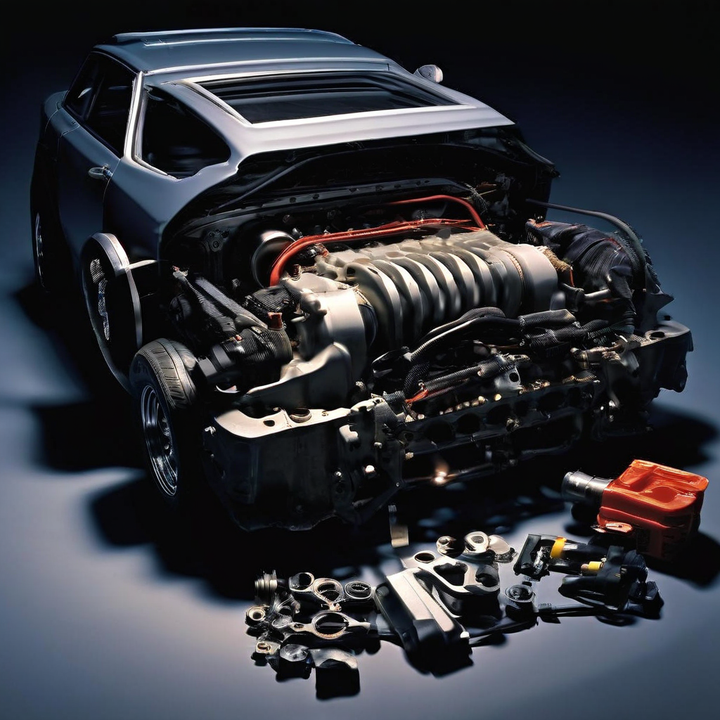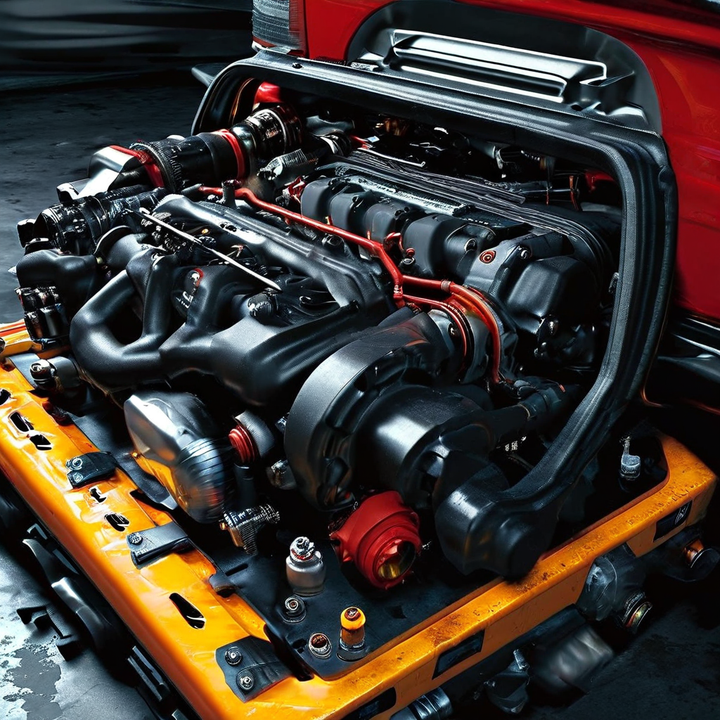


The P0310 code indicates a misfire in cylinder 10 of your engine. Misfires can lead to poor engine performance, increased emissions, and potential damage to the catalytic converter. Understanding the causes, repair techniques, and preventive measures is crucial for maintaining your vehicle's health.
No fuel or low fuel quality: Poor fuel quality can lead to incomplete combustion, causing misfires.
Low fuel pressure: Insufficient fuel pressure can prevent the proper amount of fuel from reaching the combustion chamber.
Defective spark plugs, wires, or boots: Worn or damaged spark plugs and wires can fail to ignite the fuel-air mixture properly.
Damaged oxygen sensor: A faulty oxygen sensor can send incorrect data to the engine control module (ECM), leading to improper fuel-air mixture.
Faulty fuel injector: A clogged or malfunctioning fuel injector can disrupt the fuel supply to the cylinder.
Exhaust gas recirculation (EGR) valve leakage: A leaking EGR valve can cause an imbalance in the air-fuel mixture.
Restricted EGR ports: Blocked EGR ports can prevent proper exhaust gas recirculation, leading to misfires.
Complete EGR system malfunction: A total failure of the EGR system can severely affect engine performance.
Vehicle timing issues: Incorrect timing can cause the spark to ignite at the wrong moment, leading to misfires.
Faulty ignition coils and wiring: Damaged ignition coils and wiring can prevent the spark plug from firing correctly.
Defective ignition module or wiring: Issues with the ignition module or its wiring can disrupt the ignition process.
Flaws in ignition system sensors: Faulty sensors can send incorrect data to the ECM, affecting the ignition timing.
Clogged catalytic converter: A clogged converter can cause backpressure, leading to misfires.
Evaporating fuel vapors into the engine: Issues with the evaporative emissions system can lead to improper fuel vapor management, causing misfires.
| Cause | Evidence |
|---|---|
| Low Fuel Quality | Poor fuel can lead to incomplete combustion, causing misfires. |
| Faulty Spark Plugs | Worn or damaged spark plugs can fail to ignite the fuel-air mixture properly. |
| Clogged Catalytic Converter | A clogged converter can cause backpressure, leading to misfires. |
Replace damaged wires and related components: Ensure all ignition-related components are working correctly and replace or repair as needed, including spark plugs, coils, and distributor cap.
Repair or replace leaking vacuum hoses: Vacuum leaks can disrupt the air-fuel mixture, leading to misfires.
Replace or repair faulty EGR valves: Ensure the EGR system is functioning correctly to maintain proper exhaust gas recirculation.
Restore defective fuel injectors: Clean or replace clogged or malfunctioning fuel injectors to ensure proper fuel delivery.
Clean and repair or replace a clogged catalytic converter: A clogged converter can cause backpressure and misfires.
Clear all codes, test-drive the vehicle, and rescan to see if any codes reappear: This ensures that the repairs have resolved the issue.
Replace the faulty powertrain control module if necessary: If the ECM is faulty, it may need to be replaced to resolve the misfire issue.
Regularly check and replace spark plugs and ignition coils: This prevents ignition-related misfires.
Inspect and clean fuel injectors periodically: Keeping injectors clean ensures proper fuel delivery.
Ensure the fuel system is free from contaminants: Using high-quality fuel and additives can help maintain a clean fuel system.
Regularly inspect and maintain the EGR system: This prevents issues related to exhaust gas recirculation.
Keep the catalytic converter clean and functional: Regular maintenance can prevent clogging and backpressure issues.
Diagnose the Issue:
Use an OBD-II scanner to check for a stored P0310 trouble code.
Check fuel levels and pressure.
Inspect all filters and spark plugs for proper function.
Visually inspect all wires and related electrical components for damage.
Repair Process:
Swap the coils, spark plugs, and spark plug wires from cylinder 10 to another cylinder to determine if they are faulty.
Check for vacuum leaks or damaged hoses.
Inspect the exhaust condition to determine if it is running rich or lean.
Check for EGR valve malfunctions and fuel injector issues.
Clean or replace the catalytic converter if clogged.
Use high-quality fuel to prevent combustion issues: This ensures proper combustion and prevents misfires.
Regularly replace spark plugs and ignition components: This prevents ignition-related issues.
Maintain the fuel system by using fuel additives to keep injectors clean: This ensures proper fuel delivery.
Perform regular inspections of the EGR system and catalytic converter: This prevents issues related to exhaust gas recirculation and backpressure.
Keep the engine's timing and ignition systems in proper working order: This ensures proper ignition timing and prevents misfires.
| Preventive Measure | Best Practice |
|---|---|
| Fuel Quality | Always use fuel with the recommended octane rating to prevent combustion issues. |
| Regular Maintenance | Schedule regular check-ups for your vehicle to catch potential issues early. |
| Use of Additives | Periodically use fuel system cleaners to prevent injector clogging. |
Diagnosing the exact cause of the misfire can be complex due to multiple potential issues: Misfires can result from various causes, making diagnosis challenging.
Some repairs, like replacing the catalytic converter, can be costly: Certain repairs may require significant investment.
Misfires can sometimes be intermittent, making them harder to diagnose: Intermittent issues can complicate the diagnostic process.
Always start with the simplest and most common causes before moving to more complex diagnostics: This approach can save time and resources.
Ensure that all repairs are done according to the manufacturer's specifications to avoid further issues: Following manufacturer guidelines ensures proper repairs and prevents additional problems.
Some may argue that minor misfires can be ignored if the vehicle still runs smoothly, but this can lead to more significant issues over time: Ignoring misfires can cause long-term damage.
Others might suggest DIY repairs to save costs, but professional diagnostics can prevent misdiagnosis and unnecessary repairs: Professional diagnostics ensure accurate identification and resolution of issues.
Understanding the P0310 code, its causes, and the appropriate repair and maintenance techniques is essential for keeping your vehicle running smoothly. Regular maintenance and prompt repairs can prevent more severe issues and ensure your engine's longevity.
Proper maintenance and timely repairs are crucial in preventing misfires and maintaining optimal engine performance. Regular check-ups and using high-quality components can save you from costly repairs in the long run.
Don't let a misfire slow you down. Stay proactive with your vehicle's maintenance, and address issues like the P0310 code promptly to keep your engine running at its best.
The P0310 code indicates a misfire in cylinder 10 of your engine, which can lead to poor engine performance, increased emissions, and potential damage to the catalytic converter.
Common causes include low fuel quality, defective spark plugs, faulty fuel injectors, damaged oxygen sensors, and issues with the EGR system.
To diagnose a P0310 code, use an OBD-II scanner to check for stored trouble codes, inspect fuel levels and pressure, and visually inspect all wires and related electrical components for damage.
Symptoms may include a check engine light, rough idling, hesitation during acceleration, and difficulty starting the vehicle.
Repair techniques include replacing damaged spark plugs, repairing or replacing faulty EGR valves, cleaning or replacing clogged catalytic converters, and ensuring all ignition-related components are functioning correctly.
Preventive measures include using high-quality fuel, regularly replacing spark plugs and ignition components, maintaining the fuel system, and performing regular inspections of the EGR system and catalytic converter.
Challenges include the complexity of diagnosing the exact cause due to multiple potential issues and the intermittent nature of some misfires, which can complicate the diagnostic process.
Ignoring a P0310 code can lead to more significant issues over time, including potential damage to the catalytic converter and increased emissions.
While some may suggest DIY repairs to save costs, professional diagnostics can prevent misdiagnosis and unnecessary repairs, ensuring accurate identification and resolution of issues.
After repairing a P0310 code, clear all codes, test-drive the vehicle, and rescan to ensure that the repairs have resolved the issue.

Miguel started tinkering with car radios as a teenager, fascinated by the intricate dance of wires and circuits. This passion led him to pursue a career as an automotive electrician. For the past 10 years, Miguel has tackled everything from flickering headlights to mysterious electrical gremlins. He thrives on troubleshooting electrical problems and enjoys sharing his knowledge to empower car owners to understand their vehicles better.



